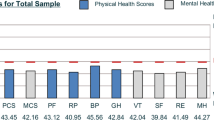Abstract
Objective: In this article, psychometric properties both of the total RAND-36 and of its subscales, such as unidimensionality, differential item functioning (DIF or item bias), homogeneity and reliabilities, are examined. Methods: The data from populations with three chronic illnesses, multiple sclerosis (n = 448), rheumatism (n = 336) and COPD (n = 259), have been collected in different parts of the Netherlands. The main technique used was Mokken scale analysis for polytomous items. Results: All subscales of the RAND-36 appeared to be unidimensional. For the sub scales ‘mental health’ and ‘general health perceptions’ some minor indications of DIF for the different chronic illnesses were found. Reliabilities of almost all subscales in all subpopulations were higher than 0.80, while the homogeneities of almost all subscales in all subpopulations were higher than 0.50, indicating ‘strong unidimensional, hierarchical scales’. Conclusions: In general, the subscales of the RAND-36 can be used to compare persons with different chronic illnesses. The subscale ‘general health perceptions’ did not function as well as would be preferred.
Similar content being viewed by others
References
Ware JE Jr, Sherbourne CD. The MOS 36–item short-from health survey (SF-36) I. Conceptual framework and item selection. Med Care 1992; 30: 473–483.
McHorney CA, Ware JE Jr, Raczek AE. The MOS 36–item short-form health survey (SF-36) II. Psychometric and clinical tests of validity in measuring physical and mental health constructs. Med Care 1993; 31(3): 247–263.
McHorney CA, Ware JE Jr, Rachel Lu JF, Sherbourne CD. The MOS 36–item short-form health survey (SF-36) III. Tests of data quality, scaling assumptions, and reliability across diverse patient groups. Med Care 1994; 32(1): 40–66.
Hays RD, Sherbourne CD, Mazel RM. The RAND 36–item health survey 1.0. Health Economics 1993; 2: 217–227.
Aaronson NK, Acquandro C, Alonso J, et al. International quality of life assessment (IQOLA) project. Qual Life Res 1992; 1: 349–351.
Ware JE Jr, Gandek B. Overview of the SF-36 health survey and the international quality of life assessment (IQOLA) project. J Clin Epidemiol 1998; 51(11): 903–912.
Ware JE Jr, Gandek B. Methods for testing data quality, scaling assumptions, and reliability: The IQOLA project approach. J Clin Epidemiol 1998; 51(11): 945–952.
Gandek B, Ware JE Jr, Aaronson NK, et al. Tests of data quality, scaling assumptions, and reliability of the SF-36 in eleven countries: Results from the IQOLA Project. J Clin Epidemiol 1998; 51(11): 1149–1158.
Sullivan M, Karlsson J, Ware JE Jr. The Swedish SF-36 Health Survey-I. Evaluation of data quality, scaling assumptions, reliability and construct validity across general populations in Sweden. Soc Sci Med 1995; 41: 1349–1358.
Bullinger M. German translation and psychometric testing of the SF-36 health survey: Preliminary results from the IQOLA project. Soc Sci Med 1995; 41(10): 1359–1366.
Lewin-Epstein N, Sagiv-Schifter T, Shabtai EL, Shmueli A. Validation of the 36–item short form health survey (Hebrew version) in the adult population of Israel. Med Care 1998; 36: 1361–1370.
Razavi D, Gandek B. Testing Dutch and French translations of the SF-36 health survey among Belgian Angina patients. J Clin Epidemiol 1998; 51(11): 975–981.
Bjorner JB, Damsgaard MT, Watt T, Groenvold M. Tests of data quality, scaling assumptions, and reliability of the Danish SF-36. J Clin Epidemiol 1998; 51(11): 1000–1011.
Leplège A, Ecosse E, Verdier A, Perneger TV. The French SF-36 health survey: Translation, cultural adaptation and preliminary psychometric evaluation. J Clin Epidemiol 1998; 51(11): 1013–1023.
Apolone G, Mosconi P. The Italian SF-36 Health Survey: Translation, validation and norming. J Clin Epidemiol 1998; 51(11): 1025–1036.
Fukuhara S, Ware JE Jr, Kosinski M, Wada S, Gandek B. Psychometric and clinical tests of validity of the Japanese health survey. J Clin Epidemiol 1998; 51(11): 1045–1053.
Aaronson NK, Muller M, Cohen PDA, et al. Translation, validation, and norming or the Dutch language version of the SF-36 Health Survey in community and chronic disease populations. J Clin Epidemiol 1998; 51(11): 1055–1068.
Bjorner JB, Kreiner S, Ware JE Jr, Damsgaard MT, Bech P. Differential item functioning in the Danish translation of the SF-36. J Clin Epidemiol 1998; 51(11): 1189–1202.
Green SB, Lissitz RW, Mulaik SA. Limitations of coefficient Alpha as an index of test unidimensionality. Educ Psychol Measur 1977; 37: 827–838.
Miller MB. Coefficient alpha: A basic introduction from the perspectives of classical test theory and structural equation modelling. Structural Equation Modeling 1995; 2: 255–273.
Niemoller K, Van Schuur W. Stochastic models for unidimensional scaling: Mokken and Rasch. In: McKay D, Schofield N, Whiteley P (eds), Data Analysis and the Social Sciences, London: Frances Pinter, 1983; 120–170.
Molenaar IW, Sijtsma K. MSP5 for Windows, A program for Mokken Scale Analysis for Polytomous Items, version 5.0 (User's manual) Groningen, The Netherlands: iecProGAMMA, 2000.
Molenaar IW. Nonparametric models for polytomous responses. In: Van de Linden WJ, Hambleton RK (eds), Handbook of Modern Item Response Theory, New York: Springer Verlag, 1997; 369–380.
Van der Zee K, Sanderman R. Het meten van de algemene gezondheidstoestand met de RAND-36: een handleiding. [The measument of the general health situation with the RAND-36: A manual]. Northern Centre for Health Care, University of Groningen, 1993.
Grayson DA. Two-group classification in latent trait theory: Scores with monotone likelihood ratio. Psychometrika 1988; 53: 383–392.
Hemker BA, Sijtsma K. Selection of unidimensional scales from a multidimensional item bank in the polytomous Mokken IRT model. Appl Psychol Measur 1995; 19(4): 337–352.
Ware JE Jr, Keller SD, Gandek B, et al. Evaluating translations of health status questionnaires. Methods from the IQOLA project. Int J Technol Assess Health Care 1995; 11: 525–551.
Author information
Authors and Affiliations
Rights and permissions
About this article
Cite this article
Moorer, P., Suurmeijer, T., Foets, M. et al. Psychometric properties of the RAND-36 among three chronic disease (multiple sclerosis, rheumatic diseases and COPD) in the Netherlands. Qual Life Res 10, 637–645 (2001). https://doi.org/10.1023/A:1013131617125
Issue Date:
DOI: https://doi.org/10.1023/A:1013131617125




